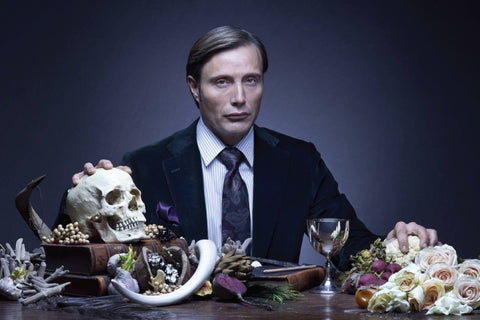The Collar Guide
Posted: May 01 2017
Choosing a shirt collar that harmonizes your features while helping you achieve a dapper look is one of the joys of having a shirt tailored. In this article you will find a short guide to pick the right collar for your outfit and make the most of your bespoke experience, as well as a little history about modern collars.

History of the Modern Collar
Collars first appeared as ornaments during the Edwardian period and were worn as jewelry until the beginning of the 20th century, but the true ancestors of modern collars are removable collars.
Removable collars were invented in 1827 by Hannah Lord Montague in New York. Back then, a great amount of resources and time was needed to launder undergarments, and it was common to wear the same shirt for longer periods. While most parts of the shirt were usually hidden by overgarments, cuffs and collars were exposed to the public eye, and more likely to get dirty. Gentlemen conveyed the illusion of cleanliness by frequently replacing only those particular portions of their shirt.
Collars and cuffs on shirts were held on with special buttons called studs, two studs for the collar (front and back) and additional studs for the cuffs (one stud for each sleeve). Collars that detached from shirts allowed separate laundering and extended a shirt’s life, and, even after the advent of mass manufacture of garments, removable collars remained a common component of men’s attire .
 The first removable collars were made of cotton and linen and usually stiffened by the use of starch.The clean-cut look of stiff, high collars, soon turned them into a formal wear essential. Collars used for formal wear were as tall as three inches and impeded head movement, a factor that contributed to the birth of wing collars, the hard collars with the front edges folded downward and that, to this day, are used for tuxedos.
The first removable collars were made of cotton and linen and usually stiffened by the use of starch.The clean-cut look of stiff, high collars, soon turned them into a formal wear essential. Collars used for formal wear were as tall as three inches and impeded head movement, a factor that contributed to the birth of wing collars, the hard collars with the front edges folded downward and that, to this day, are used for tuxedos.
White removable collars soon were worn for business and leisure as well. The white stiffness of the accessory was often used to balance bright coloured shirts, and by the time office work became more available in the 1900, the term “white collar worker” was coined to refer to business professionals.
 Collars lost their stiffness during WWI, when detachable spread collars and extended flat collars of softer materials were introduced as part of uniforms, favouring comfort over looks. The comfort and ease of soft collars made it hard for soldiers to go back to the former stiff counterparts, and a heated fashion dispute erupted, with the most conservative arguing in club rooms for keeping the stiff collar in men’s wardrobes.
Collars lost their stiffness during WWI, when detachable spread collars and extended flat collars of softer materials were introduced as part of uniforms, favouring comfort over looks. The comfort and ease of soft collars made it hard for soldiers to go back to the former stiff counterparts, and a heated fashion dispute erupted, with the most conservative arguing in club rooms for keeping the stiff collar in men’s wardrobes.
With the passing of the years, living standards improved, it became easier to purchase and wash clothes, and detachable collars were replaced by attached collars. By then, shirt’s collars had become a symbol of distinction and a way of expressing both status and personality. Today, collars are of course used in both formal and casual occasions, and are made to be comfortable (at least ours at Tailor On Ten are).
While there is still some debate about the necessity of collars, there is no doubt that a collar framing your face correctly will make you look your best, and knowing the difference between a Cutaway and a Kent is what can make the difference when choosing a shirt.
How to...
Collars are like a frame to your face and learning how to choose the right one to lend personality to your attire, and compliment your features from the shoulders up, is important.
The most commonly used collars here at Tailor On Ten are Kent, Cutaway, Full Spread, Mandarin and Wing Collars. Most variations can have a button down and hidden button down option, and the choice of collar is usually based on our customer’s preference and face shape. Among them, the Cutaway is by far and away the most popular choice, since it looks contemporary and tends to work well for everyone.
Usually the shape of a collar is chosen to de-emphasize dominant face features. The look of narrow faces tend to benefit from spread collars, while narrow collars add grace to rounder physiognomies.
Collar size and length can also help framing the wearer’s shoulders and head, and as a rule of thumb, pronounced face shapes (round or long), go best with larger collars. Smaller heads and shoulders look more proportionate with a smaller collar instead. Another factor to take into account is the collar length, usually, the smaller the collar, the more modern and informal the attire.
 KENT
KENT
Kent is a standard business collar, found on many dress shirts. It has quite a narrow gap between collar points and looks great with a small tie knot. This collar is appropriate for rounder faces.
 CUTAWAY
CUTAWAY
Cutaway is somewhat wider than a kent collar. Our cutaway is quite gentle and tends to be the most universally flattering. Works with any tie knot and most face types.
 FULL SPREAD
FULL SPREAD
Full spread has a large gap between collar points, creating a near-horizontal line. Definitely a collar that will stand out, but a constant favourite in bespoke circles. Particularly suits a longer face.
 BUTTON DOWN KENT
BUTTON DOWN KENT
Button down - Kent has buttons to tie down the collar points. This makes the style much more casual and is the classic option for weekend shirts. Face shapes are less important for button down collars, as they tend to be worn open.
 HIDDEN BUTTON DOWN KENT
HIDDEN BUTTON DOWN KENT
Hidden button down - Kent has hidden buttons to fasten the points of the collar. This keeps the collar in place but makes the collar somewhat inwards rounded along the collar band, unlike the classic straight business collar that is kept stiff by collar stays.
 MANDARIN
MANDARIN
Mandarin is not a turn-down collar. It has a single strip of fabric that fastens with a button and is a very casual option.
 WING
WING
Wing collars are worn with a tuxedo and bow tie. The wings should be tucked behind the bow tie.
 BUTTON DOWN CUTAWAY
BUTTON DOWN CUTAWAY
Button down - Cutaway is a modern interpretation of the button down. The wider collar is appropriate for longer faces, but will stand out as a more unusual choice.
 HIDDEN BUTTON DOWN CUTAWAY
HIDDEN BUTTON DOWN CUTAWAY
Hidden Button - Cutaway is for those who like a more spread collar, kept neatly in place. Looks good with small color wings, worn without a tie.
There you go, now you know the theory. To get some personal guidance on what would suit you best, don’t hesitate to get in touch. Still, the single biggest issue men have with collars is that they feel strangled, which is simply because the collar is too small. So do yourself a favor and go bespoke!










